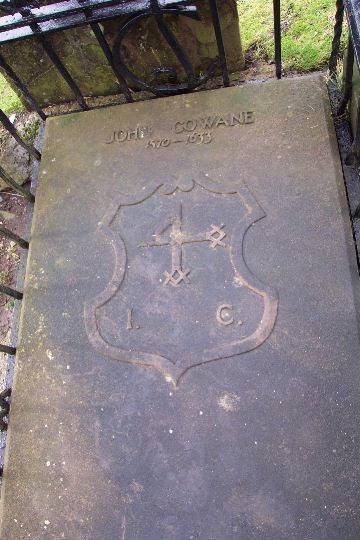For more information, see:
Related Topics:

Our mailbox often contains some very interesting things. In July, 2002, we received the following:
 Dear
Brother:
Dear
Brother:
Attached is a photo of a grave in Stirling, Scotland of a John Cowane. He was a wealthy merchant and gild leader there... 1570 to 1633. I was touched by his grave art which included the passage "I WAS HVNGRIE AND YE GAVE ME MEATE... I WAS THIRSTIE AND YE GAVE ME DRINKE..."
He was apparently a very prominent and well honored man of this town; and had built a "hospital" for 13 of his ailing guild brothers upon this death.
What caught my interest was his "mark"(?) symbol on his grave which included two representations of what could be interpreted as "square and compasses."
Could this have been representations of an operative Masonic connection? Or maybe some kind of proto- speculative- masonic symbolisms. Anyway, the romantic part of me loved to think of men in the past doing worthy work of their craft (whatever that may have been back then).
I have other photos of this grave (as well as some other gravestones containing symbols or marks... some of which also contain "square and compass like" symbolism. They are all in the graveyard which lies in the saddle on the hill between Stirling Castle and its old Kirk of the Holy Rude (an area called "The Valley").
Below are some descriptions of John Cowane from internet sites...
Fraternally, Jon Knapp
John Cowane, born 1570, was a wealthy trader and merchant of Stirling. Always a public minded citizen his public offices included Councillor, baillie and Burgh representative to the Convention of Royal Burghs. Dean of Guild from 1624 --1633 he was also Member of Parliament for Stirling from 1625--1632. his sudden death in October at the age of 63 came as a shock to the Burgh and, although he died without leaving a will he told his brother Alexander that he wished to leave 500 merks to the Church of the Holy Rude, but that he particularly wanted the very lage sum of 40,000 merks to be used to establish am almshouse or hospital for the needy of the Burgh.
Responding to this generosity the Town Council arranged for the demolition of property adjoining the Church of the Holy Rude and building comenced in 1637. due to the plague and other holdups the building was not finished until 1649 when the commemorative statue of John Cowan was also carved and erected. Familiarly in the town this statue is called 'Auld Staney Breeks' and is reputed to come down to join revellers from time to time!!!!!. (For visitors requiring a translation, Auld-old, staney-stone, breeks- trousers.)
Its use as an almshouse did not last long as in 1651 Cromwell's troops under General Monck occupied it as a barracks. Indeed the stonework of the tower of the Holy Rude and some of the gravestones show musket ball marks to this day. Cowanes Hospital functioned as a hospital and comprised seven bedrooms each to accommodate two men, a hall and accommodation for the staff. Facilities were adequate but spartan and the rules were strict. Above the main entrance lies the following inscription.
THIS HOSPITALL
WAS ERECTED AND
LARGELY PROVYDED
BY IOHN COWANE
DEAN OF GILD FOR
THE ENTERTAINMENT
OF DECAYED GILD
BRIETHER
from 1721 the building was also known as The Guildhall as it was there that the Burgh guildry met. something like Trades Union the guilds controlled trade and trades people in the Town. The present Guildhall dates from renovations carried out in 1852. Nowadays the Guildhall is used for a wide variety of functions ranging from dances, fiddle music concerts, exhibitions and weddings.
Stirling's most eminent benefactor. On his death bed he explained his wishes to his brother Alexander, part of which was to provide accommodation for twelve 'decayed' guild brethren and it shall be called "Cowane's Hospital" for all time. In the tower, there is a statue is of John Cowane, which is accepted as a good likeness.
Stirling Cowane's Hospital
Until recently used as the Guildhall, this E-shaped building was founded by John Cowane (c 1570-1633) as an almshouse to accommodate 12 "decayed" brethren. Built between 1633 and 1639 the premises included a refectory with sleeping accommodation above. The donor, a member of the Council of Royal Burghs and Scots Parliament, a man of some substance, stands jauntily above the doorway. Known affectionately as "stany breeks", he is said to come to life at Hogmanay.



